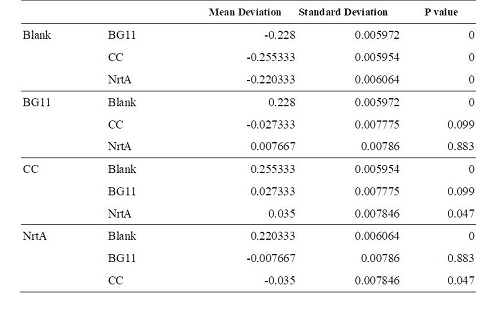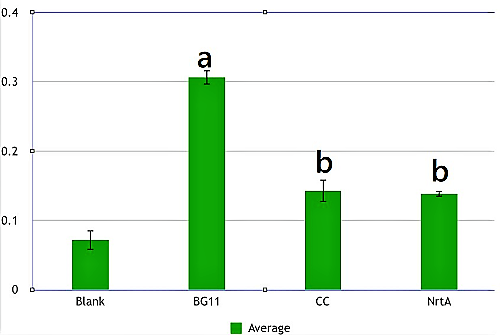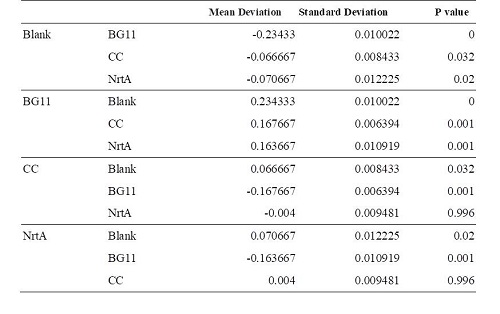Difference between revisions of "Part:BBa K2350017"
(→Analysis) |
|||
| Line 24: | Line 24: | ||
| − | '''Table 1.''' | + | '''Table 1.''' Blank:nitrate concentration assay kit assay buffer CC:competent cell BG11:microalgae culture medium buffer NrtA:NrtA producing E.coli. |
[[Image:S_NRTAAA.jpg]] | [[Image:S_NRTAAA.jpg]] | ||
| − | The nitrate and nitrite concentration of competent cell and NrtA was significant different. The results indicated that NrtA protein can capture nitrite and nitrate | + | The nitrate and nitrite concentration of competent cell and NrtA was significant different. The results indicated that NrtA protein can capture nitrite and nitrate. |
| − | + | == == | |
| − | + | ||
Then we wanted to know whether the engineered E.coli could decrease nitrate and nitrite in the environment. We used Cayman Nitrate/Nitrite Colorimetric Assay Kit to measure the nitrate and nitrite concentration of the supernatant of the engineered E.coli liquid culture. | Then we wanted to know whether the engineered E.coli could decrease nitrate and nitrite in the environment. We used Cayman Nitrate/Nitrite Colorimetric Assay Kit to measure the nitrate and nitrite concentration of the supernatant of the engineered E.coli liquid culture. | ||
Revision as of 15:25, 29 October 2017
J23118-B0034-NrtA-B0015
NrtA (a part of nitrate channel protein from Synechocystis sp. PCC 6803)
This part produces a part of nitrate channel protein from Synechocystis sp. PCC 6803 which plays the role of catching nitrate ion from the environment.
Usage and Biology
NrtA is a high-affinity periplasmic solute-binding lipoprotein .It is composed of two domains. Both domains consist of a five-stranded mixed -sheet surrounded by helices. Nitrate occupies the cleft between the two domains in catching phase. Like most bacterial periplasmic-binding proteins, NrtA is tethered to the membrane surface by a lipidated cysteine and a very long flexible linker rich in glycine and serine. Therefore NrtA is akin to a ‘‘balloon on a string’’with its solute-binding domain capturing nitrate/nitrite in the periplasm and transporting it to the NrtB transmembrane permease. The order of the strands within domain from some researchers’ point of view suggest that NrtA belongsto class II of the periplasmic-binding protein (PBP) superfamily (7) which also includes the oxyanion-binding proteins. These structures consist of two globular domains of mixed sheet flanked by helices, with the solute-binding cleft located between the two domains. However, NrtA has an extra 100aa extending from the C terminus. These residues comprise several -helices and a two-stranded antiparallel -sheet that cradle the back of the C-clamp. This architectural feature provides structural support for the nitrate-binding pocket or plays a role in the conformational changes associated with solute transport. The resonance state of the nitrate anion in NrtA binding pocket evenly distributes the negative charge among the three oxygen atoms. However, the environment surrounding the nitrate oxygens in the NrtA binding pocket is clearly asymmetric. It seems likely that the O1 and O3 interactions will remain the same but that the O2 atom and its interactions with the protein will be absent in the case of nitrite. O2 in the bound nitrate molecule has relatively few interactions and, hence, maybe the reason why NrtA binds nitrate and nitrite with approximately the same affinity.[1] We arrange the coding region with a moderate constitutive promoter, and then nrtA will be all over the modified microbe’s cell membrane.
Analysis
To test whether NrtA protein could capture nitrate and nitrite, we used French Pressure Press to isolate NrtA protein, and used Cayman Nitrate/Nitrite Colorimetric Assay Kit to measure the nitrate and nitrite concentration in the medium with NrtA protein.
Figure 1. Nitrate absorbance of different cell lysate. Blank:nitrate concentration assay kit assay buffer CC:competent cell BG11:microalgae culture medium buffer NrtA:NrtA producing E.coli.
Table 1. Blank:nitrate concentration assay kit assay buffer CC:competent cell BG11:microalgae culture medium buffer NrtA:NrtA producing E.coli.
The nitrate and nitrite concentration of competent cell and NrtA was significant different. The results indicated that NrtA protein can capture nitrite and nitrate.
Then we wanted to know whether the engineered E.coli could decrease nitrate and nitrite in the environment. We used Cayman Nitrate/Nitrite Colorimetric Assay Kit to measure the nitrate and nitrite concentration of the supernatant of the engineered E.coli liquid culture.
Figure 2. Nitrate absorbance of cell. Blank:nitrate concentration assay kit assay buffer CC:competent cell BG11:microalgae culture medium buffer NrtA:NrtA producing E.coli.
Table 2. Dunnett 3. Blank:nitrate concentration assay kit assay buffer CC:competent cell BG11:microalgae culture medium buffer NrtA:NrtA producing E.coli
The nitrate and nitrite concentration of NrtA and competent cell had slight but not significant difference. The result implied that NrtA protein could capture nitrate and nitrite while the engineered E.coli with NrtA gene couldn’t. The engineered E.coli with NrtA gene could express NrtA protein, while NrtA protein might be inside the cell, so nitrate and nitrite concentration outside the cell didn’t change a lot.
References
1. Atomic structure of a nitrate-binding protein crucial for photosynthetic productivity Nicole M. Koropatkin*, Himadri B. Pakrasi†, and Thomas J. Smith*‡ Koropatkin et al.PNAS June 27, 2006 vol. 103 no. 26 9821
2. Substrate-binding Lipoprotein of the Cyanobacterium Synechococcus sp. Strain PCC 7942 Involved in the Transport of Nitrate and Nitrite* Shin-ichi Maeda and Tatsuo Omata‡ THE JOURNAL OF BIOLOGICAL CHEMISTRY Vol. 272, No. 5, Issue of January 31, pp. 3036 –3041, 1997
3. Genetically engineered mutant of the cyanobacterium Synechococcus PCC 7942 defective in nitrate transport TATSUO OMATA*, MASAYUKI OHMORIt, NOBUYUKI ARAi*, AND TERUO OGAWA* Proc. Nati. Acad. Sci. USA Vol. 86, pp. 6612-6616, September 1989
J23118-B0034-NrtA-B0015
- 10COMPATIBLE WITH RFC[10]
- 12INCOMPATIBLE WITH RFC[12]Illegal NheI site found at 7
Illegal NheI site found at 30 - 21INCOMPATIBLE WITH RFC[21]Illegal BglII site found at 1240
Illegal BamHI site found at 610 - 23COMPATIBLE WITH RFC[23]
- 25COMPATIBLE WITH RFC[25]
- 1000COMPATIBLE WITH RFC[1000]




